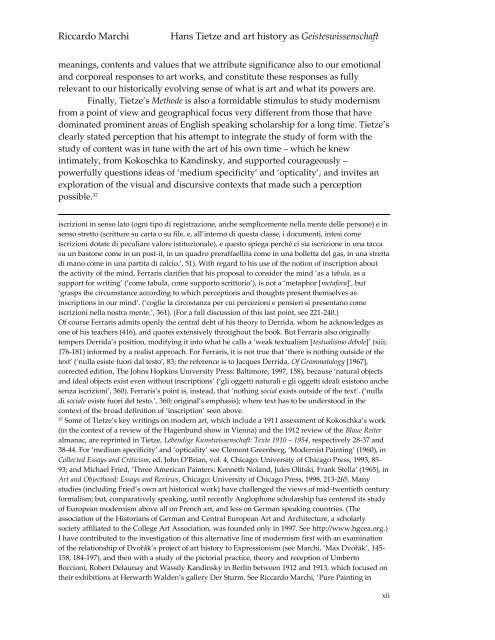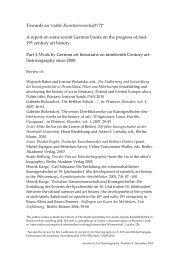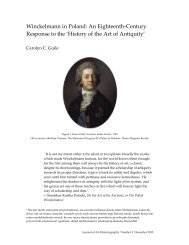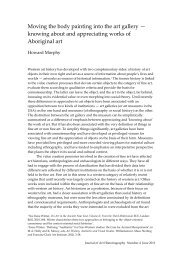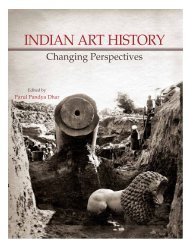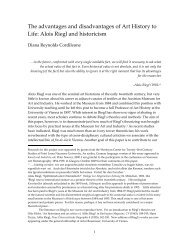Geisteswissenschaft - Journal of Art Historiography
Geisteswissenschaft - Journal of Art Historiography
Geisteswissenschaft - Journal of Art Historiography
You also want an ePaper? Increase the reach of your titles
YUMPU automatically turns print PDFs into web optimized ePapers that Google loves.
Riccardo Marchi Hans Tietze and art history as <strong>Geisteswissenschaft</strong><br />
meanings, contents and values that we attribute significance also to our emotional<br />
and corporeal responses to art works, and constitute these responses as fully<br />
relevant to our historically evolving sense <strong>of</strong> what is art and what its powers are.<br />
Finally, Tietze’s Methode is also a formidable stimulus to study modernism<br />
from a point <strong>of</strong> view and geographical focus very different from those that have<br />
dominated prominent areas <strong>of</strong> English speaking scholarship for a long time. Tietze’s<br />
clearly stated perception that his attempt to integrate the study <strong>of</strong> form with the<br />
study <strong>of</strong> content was in tune with the art <strong>of</strong> his own time – which he knew<br />
intimately, from Kokoschka to Kandinsky, and supported courageously –<br />
powerfully questions ideas <strong>of</strong> ‘medium specificity’ and ‘opticality’, and invites an<br />
exploration <strong>of</strong> the visual and discursive contexts that made such a perception<br />
possible. 37<br />
iscrizioni in senso lato (ogni tipo di registrazione, anche semplicemente nella mente delle persone) e in<br />
senso stretto (scritture su carta o su file, e, all’interno di questa classe, i documenti, intesi come<br />
iscrizioni dotate di peculiare valore istituzionale), e questo spiega perché ci sia iscrizione in una tacca<br />
su un bastone come in un post-it, in un quadro preraffaellita come in una bolletta del gas, in una stretta<br />
di mano come in una partita di calcio.’, 51). With regard to his use <strong>of</strong> the notion <strong>of</strong> inscription about<br />
the activity <strong>of</strong> the mind, Ferraris clarifies that his proposal to consider the mind ‘as a tabula, as a<br />
support for writing’ (‘come tabula, come supporto scrittorio’), is not a ‘metaphor [metafora]’, but<br />
‘grasps the circumstance according to which perceptions and thoughts present themselves as<br />
inscriptions in our mind’. (‘coglie la circostanza per cui percezioni e pensieri si presentano come<br />
iscrizioni nella nostra mente.’, 361). (For a full discussion <strong>of</strong> this last point, see 221-240.)<br />
Of course Ferraris admits openly the central debt <strong>of</strong> his theory to Derrida, whom he acknowledges as<br />
one <strong>of</strong> his teachers (416), and quotes extensively throughout the book. But Ferraris also originally<br />
tempers Derrida’s position, modifying it into what he calls a ‘weak textualism [testualismo debole]’ (xiii;<br />
176-181) informed by a realist approach. For Ferraris, it is not true that ‘there is nothing outside <strong>of</strong> the<br />
text’ (‘nulla esiste fuori dal testo’, 83; the reference is to Jacques Derrida, Of Grammatology [1967],<br />
corrected edition, The Johns Hopkins University Press: Baltimore, 1997, 158), because ‘natural objects<br />
and ideal objects exist even without inscriptions’ (‘gli oggetti naturali e gli oggetti ideali esistono anche<br />
senza iscrizioni’, 360). Ferraris’s point is, instead, that ‘nothing social exists outside <strong>of</strong> the text’. (‘nulla<br />
di sociale esiste fuori del testo.’, 360; original’s emphasis); where text has to be understood in the<br />
context <strong>of</strong> the broad definition <strong>of</strong> ‘inscription’ seen above.<br />
37 Some <strong>of</strong> Tietze’s key writings on modern art, which include a 1911 assessment <strong>of</strong> Kokoschka’s work<br />
(in the context <strong>of</strong> a review <strong>of</strong> the Hagenbund show in Vienna) and the 1912 review <strong>of</strong> the Blaue Reiter<br />
almanac, are reprinted in Tietze, Lebendige Kunstwissenschaft: Texte 1910 – 1954, respectively 28-37 and<br />
38-44. For ‘medium specificity’ and ‘opticality’ see Clement Greenberg, ‘Modernist Painting’ (1960), in<br />
Collected Essays and Criticism, ed. John O’Brian, vol. 4, Chicago: University <strong>of</strong> Chicago Press, 1993, 85-<br />
93; and Michael Fried, ‘Three American Painters: Kenneth Noland, Jules Olitski, Frank Stella’ (1965), in<br />
<strong>Art</strong> and Objecthood: Essays and Reviews, Chicago: University <strong>of</strong> Chicago Press, 1998, 213-265. Many<br />
studies (including Fried’s own art historical work) have challenged the views <strong>of</strong> mid-twentieth century<br />
formalism; but, comparatively speaking, until recently Anglophone scholarship has centered its study<br />
<strong>of</strong> European modernism above all on French art, and less on German speaking countries. (The<br />
association <strong>of</strong> the Historians <strong>of</strong> German and Central European <strong>Art</strong> and Architecture, a scholarly<br />
society affiliated to the College <strong>Art</strong> Association, was founded only in 1997. See http://www.hgcea.org.)<br />
I have contributed to the investigation <strong>of</strong> this alternative line <strong>of</strong> modernism first with an examination<br />
<strong>of</strong> the relationship <strong>of</strong> Dvořák’s project <strong>of</strong> art history to Expressionism (see Marchi, ‘Max Dvořák’, 145-<br />
158, 184-197), and then with a study <strong>of</strong> the pictorial practice, theory and reception <strong>of</strong> Umberto<br />
Boccioni, Robert Delaunay and Wassily Kandinsky in Berlin between 1912 and 1913, which focused on<br />
their exhibitions at Herwarth Walden’s gallery Der Sturm. See Riccardo Marchi, ‘Pure Painting in<br />
xii


